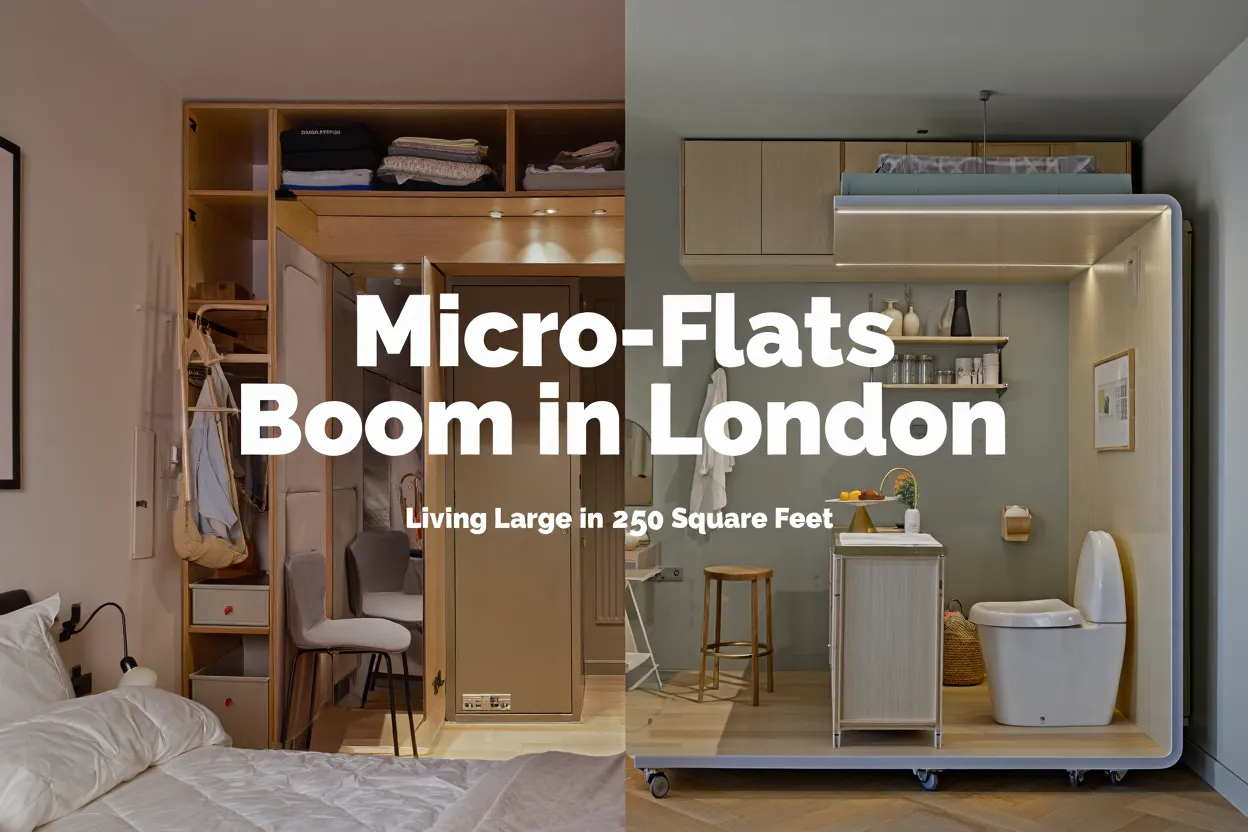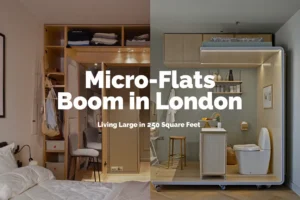London’s Big Problem, Small Solution
If London housing were a Monopoly board, every prime square would already be stacked with hotels, leaving little room for newcomers. Property prices in the UK capital have soared to the point where owning a conventional flat is more dream than reality for many.
Enter the micro-flat: homes as small as 250 sq ft (23 m²), ingeniously designed to fit all the essentials into one compact footprint. For some, they’re a clever lifestyle hack; for others, they’re a symptom of a broken housing market.
“Micro-flats are like London’s witty retort to impossible house prices,” says Deepak Shukla, founder of Pearl Lemon Properties. “It’s the city saying: ‘You can’t afford a mansion, but here’s a box with soul, right where the action is.’”
The Numbers Behind the Boom
This isn’t just a design fad, it’s a genuine housing trend backed by statistics:
- 1 in 20 London homes (5%) are now classed as micro-apartments under 37 m².
- Between 1,000 and 2,000 new units are built annually, about 3% of all new housing.
- The sector has doubled in the past five years, particularly in boroughs like Croydon, Southwark, and Camden.
This acceleration owes much to permitted development rights, introduced in 2013, which allowed developers to bypass minimum space rules when converting offices into flats. The result? An explosion of micro-dwellings tucked inside former commercial blocks across the city.
Why Londoners Are Choosing Micro
Londoners increasingly prioritise being near transport, jobs, and nightlife over having a spacious living room. A 250-sq-ft studio in Zone 1 can rival the appeal of a two-bed in Zone 6.
“Most people spend their day in offices, cafés, and gyms. Their home is where they crash, recharge, and maybe watch a Netflix episode,” notes Deepak. “For that lifestyle, a micro-flat isn’t a compromise, it’s an optimization.”
Co-Living & Community
Micro-flats often integrate with co-living amenities: gyms, lounges, co-working hubs, even rooftop gardens. The Collective Old Oak in Willesden, for instance, offers 200–350 sq ft studios with shared kitchens and events programmes.
Sustainability & Energy Efficiency
Tiny homes consume less power. Heating a 23-sqm flat requires far less energy than a semi-detached house. Developers also tout sustainable building materials and smart tech like app-controlled thermostats.
How to Live Big in 250 Sq Ft
Inside a micro-flat, every centimetre counts. Architects use:
- Convertible furniture – sofa-beds, Murphy beds, and fold-out dining tables.
- Vertical storage – tall cupboards and under-bed drawers.
- Flexible partitions – sliding walls to create “rooms” when needed.
- Illusion tricks – mirrors, light tones, and large windows to expand perception.
Living the Micro-Life: Stories from Inside
To understand the appeal, imagine this:
- Morning: You fold your bed into the wall, revealing a desk. Your room becomes an office.
- Evening: Slide the desk away, pull out a dining table, and cook on a compact induction hob.
- Weekend: You meet friends in the building’s co-working café or rooftop terrace, leaving your flat uncluttered.
For students, young professionals, and digital nomads, this multi-modal lifestyle is liberating.
But critics argue that life in a shoebox comes with hidden costs.
On Reddit, one Londoner scoffed:
“They’re just calling them ‘micro-flats’ to make cramped converted houses where you eat dinner on your bed sound quaint and fun.”
Another noted:
“£1,795 for 200 sq ft in Croydon is absurd. That’s not affordable, it’s a luxury shoebox.”
The Dark Side of Small
While micro-flats offer smart urban solutions, they come with caveats:
- Claustrophobia: Limited space can impact mental health, especially during remote work.
- Noise & privacy: Thin walls in conversions often mean hearing every neighbour’s kettle boil.
- Price paradox: They cost 30% more per square metre than average flats.
- Investment limits: Smaller than 37 m²? Properties grow just 6.9% in value vs 8.7% for larger homes.
“The danger,” Deepak warns, “is when developers cut corners and build glorified cupboards. That’s when micro-flats become micro-problems.”
Global Micro-Movements: How London Compares
London isn’t alone, micro-living is a worldwide experiment:
- Tokyo: 95% of apartments are under 30 m². Many include capsule-style layouts optimised for single workers.
- Hong Kong: The infamous “nano-flats” average just 128 sq ft, barely larger than a parking space.
- New York: The city trialled “My Micro NY” apartments at 260–360 sq ft, targeting young professionals.
What makes London unique is its mix of historic housing stock, permitted development conversions, and demand from international renters.
Investors’ Angle: Are Micro-Flats Worth It?
For buy-to-let landlords, micro-flats are a mixed bag:
- High rental yields: Renters pay for central location, not square footage. Yields can outpace larger flats.
- Steady demand: International students and young professionals keep occupancy rates high.
- Weak capital growth: Sub-37 m² properties underperform on resale.
Policy Wars: Slum or Solution?
Not everyone is cheering for the micro-boom. Critics argue that converting old offices into rabbit-hutch flats risks creating modern “slums.”
In 2024, a Guardian investigation revealed poorly ventilated, windowless micro-units being rented for premium prices. Labour was accused of permitting “a new generation of slum homes”.
Supporters counter that micro-flats meet demand: without them, many renters would face long commutes or leave London altogether.
This tension highlights the delicate balance between innovation and exploitation.
The Future: Tech-Powered Micro-Living
Looking forward, the micro-flat of 2030 may look very different:
- AI-assisted layouts: Custom design software optimising furniture placement.
- Smart walls: Screens doubling as partitions, TV, and workspace.
- Well-being tech: Ventilation and lighting systems that mimic natural cycles.
- Circular economy: Eco-materials, shared laundry, and communal EV charging.
Deepak predicts:
“Micro-flats will evolve beyond necessity into lifestyle choices. Imagine a future where you rent a 250-sq-ft flat, but gain 10,000 sq ft of shared space, a gym, a cinema, a garden in the sky.”
Could Other UK Cities Follow?
If London is the test lab, cities like Manchester, Birmingham, Leeds, and Bristol may be next.
Rising student populations, growing tech hubs, and limited space make them ripe for micro-flat clusters. But councils will need robust guidelines to avoid London’s pitfalls, ensuring light, ventilation, and shared amenities are non-negotiable.
Conclusion: Small Homes, Big Debate
Micro-flats are London’s paradox in brick and mortar. They’re both ingenious and controversial, a creative solution for some, a cynical loophole for others.
They embody the trade-offs of urban life: affordability vs. comfort, density vs. design, opportunity vs. compromise.
And maybe, just maybe, living large in London doesn’t require a palace, just a cleverly designed box with a big city on your doorstep.
References
- King’s College London – No Space Like Home: The Geography of Micro-Apartments in London (2021). kcl.ac.uk
- The Guardian – UK boom in microflats as property prices soar (Nov 2021). theguardian.com
- London Daily News – The Shrinking British Home: Maximising Space in London’s Smallest Living Spaces (2024). londondaily.news
- South East Online – The Shrinking British Home (2024). southeastonline.co.uk
- Independent – Millennials priced out: why microflats are booming in London (2017). independent.co.uk
- Wellbeing News – The Rise of Micro Apartments in London: Living Large in Tiny Spaces (2024). wellbeingnews.co.uk
- A9 Architecture – The Future of Urban Living: Micro-Apartments and Compact Design (2024). a9architecture.co.uk
- The Guardian – Labour condemned for allowing ‘slum homes’ (Dec 2024). theguardian.com
- Evening Standard – Tiny flats built to solve London’s housing crisis may not be a good investment (2017). standard.co.uk
- Reddit London – Discussion: Microflats in London (2021). reddit.com
- Reddit HousingUK – Croydon micro-apartment prices (2023). reddit.com





